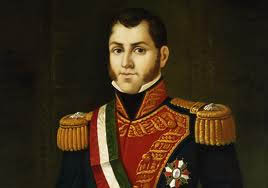By: Daniel Nardini
 Much controversy remains surrounding the historical figure Agustin de Iturbide. Born into a prominent criollo (those born of Spanish blood in the Americas) family in 1783, Iturbide became a soldier and then officer in the Royal Spanish Army in New Spain (Mexico). Eventually he became general, and his life seemed pretty much assured that he would remain a part of Spanish authority in New Spain. Then in 1810, another criollo named Miguel Hidalgo y Costilla started a revolt in Dolores that spread throughout central New Spain and nearly took the capital City of New Spain. Interestingly enough, Hidalgo actually offered Iturbide a command of one of the rebel armies, but Iturbide refused. Instead Iturbide fought in the Spanish royalist army and helped to defeat Hidalgo and also Hidalgo’s follower Jose Maria Morelos. Only Vicente Guerrero, one of Morelos’ followers, was left.
Much controversy remains surrounding the historical figure Agustin de Iturbide. Born into a prominent criollo (those born of Spanish blood in the Americas) family in 1783, Iturbide became a soldier and then officer in the Royal Spanish Army in New Spain (Mexico). Eventually he became general, and his life seemed pretty much assured that he would remain a part of Spanish authority in New Spain. Then in 1810, another criollo named Miguel Hidalgo y Costilla started a revolt in Dolores that spread throughout central New Spain and nearly took the capital City of New Spain. Interestingly enough, Hidalgo actually offered Iturbide a command of one of the rebel armies, but Iturbide refused. Instead Iturbide fought in the Spanish royalist army and helped to defeat Hidalgo and also Hidalgo’s follower Jose Maria Morelos. Only Vicente Guerrero, one of Morelos’ followers, was left.
By 1815, after Morelos was executed, the independence movement was all but crushed. The last independence rebel, Vicente Guerrero, was on the run and still fighting Spanish rule with a small guerrilla force. The fight for independence seemed lost, and it seemed that Spanish rule was secured. But then events in Spain would change the whole situation in New Spain. Although Spain regained its independence from France, the Spanish Crown came under the influence of the Liberal Party. The Spanish Conservative Party, which opposed the Liberals, fought to contest the new Spanish government. New Spain became an extension of this Liberal-Conservative fight. Many New Spain criollos, who were very conservative, did not want to be ruled by the Spanish Liberals. Underneath this political cauldron was the issue of who should really rule New Spain. The criollos, although they had de facto control of the economy, had no political control over the land. Control of the country still rested with the peninsulares (Spanish citizens born and raised in Spain). A growing number of criollos wanted to get rid of the peninsulares, and this meant the end of Spanish rule.
Likewise, Iturbide was having a change of heart. He had briefly been dismissed from his command by the Spanish viceroy, only to barely be reinstated. Because he was a criollo, he was still treated as a second class person by the Spanish Crown. He had had enough. He entered secret negotiations with his former foe Vicente Guerrero and came to an agreement with the former rebel that in exchange for getting rid of Spanish rule, Guerrero consented to Iturbide becoming head of state. And so, in 1821, New Spain had declared itself free and became Mexico. Iturbide headed a provisional government that took control of Mexico City. Sadly, the fight between Liberals and Conservatives in Spain spilled over into Mexico. Iturbide, believing that only a monarchy could preserve the newly independent Mexico, declared himself Mexico’s first emperor and ruled Mexico for a year. In 1823, Iturbide was deposed by one of his generals, Antonio Lopez de Santa Anna with the aid of Guerrero who wanted a republic. Iturbidy went into exile, but returned to Mexico in 1824. What he did not know was that the Mexican government had issued an order for his arrest and execution. Iturbide was executed on July 19, 1824.
In 1833, Mexican President Santa Anna tried to rehabilitate the memory of Iturbide. Iturbide’s remains were brought to Mexico City for full military honors. The next Mexican President, Anastasio Bustamante, provided Iturbide’s widow with a stipend, and the Mexican Congress conferred all honors on the memory of Iturbide. From loyal servant of the Spanish Crown to becoming the man who freed Mexico, Iturbide will also long be remembered as the chief designer of Mexico’s modern flag of the tricolor of green, white and red with the Aztec Eagle in the middle.

 Mayor Brandon Johnson Vetoes ‘Snap Curfew’ Ordinance June 26, 2025
Mayor Brandon Johnson Vetoes ‘Snap Curfew’ Ordinance June 26, 2025

 Esemble Español Searching for New Artistic Director June 26, 2025
Esemble Español Searching for New Artistic Director June 26, 2025







Reluctant Independence Fighter
By: Daniel Nardini
By 1815, after Morelos was executed, the independence movement was all but crushed. The last independence rebel, Vicente Guerrero, was on the run and still fighting Spanish rule with a small guerrilla force. The fight for independence seemed lost, and it seemed that Spanish rule was secured. But then events in Spain would change the whole situation in New Spain. Although Spain regained its independence from France, the Spanish Crown came under the influence of the Liberal Party. The Spanish Conservative Party, which opposed the Liberals, fought to contest the new Spanish government. New Spain became an extension of this Liberal-Conservative fight. Many New Spain criollos, who were very conservative, did not want to be ruled by the Spanish Liberals. Underneath this political cauldron was the issue of who should really rule New Spain. The criollos, although they had de facto control of the economy, had no political control over the land. Control of the country still rested with the peninsulares (Spanish citizens born and raised in Spain). A growing number of criollos wanted to get rid of the peninsulares, and this meant the end of Spanish rule.
Likewise, Iturbide was having a change of heart. He had briefly been dismissed from his command by the Spanish viceroy, only to barely be reinstated. Because he was a criollo, he was still treated as a second class person by the Spanish Crown. He had had enough. He entered secret negotiations with his former foe Vicente Guerrero and came to an agreement with the former rebel that in exchange for getting rid of Spanish rule, Guerrero consented to Iturbide becoming head of state. And so, in 1821, New Spain had declared itself free and became Mexico. Iturbide headed a provisional government that took control of Mexico City. Sadly, the fight between Liberals and Conservatives in Spain spilled over into Mexico. Iturbide, believing that only a monarchy could preserve the newly independent Mexico, declared himself Mexico’s first emperor and ruled Mexico for a year. In 1823, Iturbide was deposed by one of his generals, Antonio Lopez de Santa Anna with the aid of Guerrero who wanted a republic. Iturbidy went into exile, but returned to Mexico in 1824. What he did not know was that the Mexican government had issued an order for his arrest and execution. Iturbide was executed on July 19, 1824.
In 1833, Mexican President Santa Anna tried to rehabilitate the memory of Iturbide. Iturbide’s remains were brought to Mexico City for full military honors. The next Mexican President, Anastasio Bustamante, provided Iturbide’s widow with a stipend, and the Mexican Congress conferred all honors on the memory of Iturbide. From loyal servant of the Spanish Crown to becoming the man who freed Mexico, Iturbide will also long be remembered as the chief designer of Mexico’s modern flag of the tricolor of green, white and red with the Aztec Eagle in the middle.